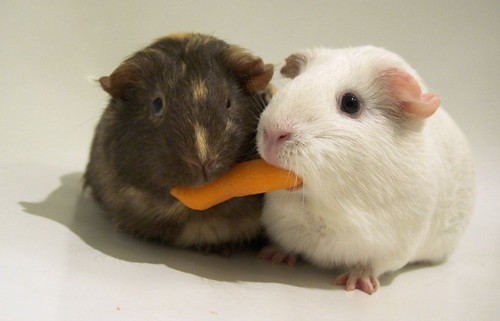Aug 12, 2010 | blog
 One of the most amazing things I’ve experienced in the past decade of social media is the aspect of sharing. From the first time I read Cluetrain to the current place it takes in the multiple buzz word lexicon of social media – sharing is a central pillar of social engagement.
One of the most amazing things I’ve experienced in the past decade of social media is the aspect of sharing. From the first time I read Cluetrain to the current place it takes in the multiple buzz word lexicon of social media – sharing is a central pillar of social engagement.
For many of us today, sharing is an easy exercise. Cut & paste a link, click a share button for a photo or embed a video in a post. We take it for granted… it’s easy!
For those getting started, or for businesses both large and small, sharing is not as clear as one would think it is. Businesses may worry about ownership of content (copyright) issues, or the context of the content they’re sharing and how it reflects or impacts their brand and reputation.
Individuals may have similar concerns, and might have trouble understanding the technical “how to’s” of proper attribution or embedding of HTML code. But that’s what the seasoned folks should be, and are, helping with – that’s a lot of what we share.
Back to sharing itself though.
As online social engagement grows with mainstream participation, people and businesses gain more from sharing than we initially realize. Giving back to the community has always been a cornerstone of corporate responsibility, and participating in online communities is easier and more cost effective than in the physical community.
Offering up tips, tricks, ideas, solutions, trials, samples, free product, services and more helps build community and reflects on individuals and brands in a positive light. Who doesn’t enjoy or respect those who are helpful? That’s not the same as giving things away simply for favors, that has it’s place in brand building, but not for community building.
Many will call it the “pay it forward” method, and indeed giving back to your community is crucial to the health of that community. It motivates others to do the same and thereby provides a basic, common knowledge to the community that benefits the whole. In the end, ideas are shared back to you or your business that you might otherwise not have thought of. And that’s always a good thing.
Photo credit: Andrew Crummy
Aug 10, 2010 | blog
 Interesting thing, communities. We live in them our entire lives. Multiple ones actually, and usually are participating in more than one at any given time.
Interesting thing, communities. We live in them our entire lives. Multiple ones actually, and usually are participating in more than one at any given time.
Today we think of communities more as online constructs, usually referring to a social network as a community. Of course, a community isn’t a tool, but rather a collection of people with similar interest.
The reality is that we participate in multiple communities because of the varied interests we have and the need to connect. We are social creatures and connecting with like-minded peers brings a certain satisfaction to our lives.
This is where the future of communications and marketing come together. Building communities around a brand isn’t misguided as some may suggest. Brands have always had followers, they’ve usually been called loyal customers. These customers are the ones that evangelize at the drop of a hat, and rally around their favorite brand, be it an automobile, soda, or candy bar.
These brand-specific communities existed before social media, indeed, before the Internet itself was useful to the average consumer. So building on that existing base, and providing added value to your brand’s community is the job at hand with social media. The opportunity for your brand is to make it easier for the average consumer to become a loyal customer.
Discover how the power of community can enhance your products and strengthen your brand. After all, why produce and sell something if it isn’t worth people getting excited about it in the first place.
Photo credit: Pink Sherbet Photography
Aug 7, 2010 | blog
 So you’ve done it, you’ve jumped on the Twitter “bandwagon”. At least, you’ve decided that its now worth your time and you’re ready to reap the rewards, whatever they are.
So you’ve done it, you’ve jumped on the Twitter “bandwagon”. At least, you’ve decided that its now worth your time and you’re ready to reap the rewards, whatever they are.
There’s been a lot of discussion in the corporate space for the use of Twitter. Why you should, why you shouldn’t, and a lot of “mushy middle” discussion around the water cooler that doesn’t really help much.
I’ve been there behind the firewall where it’s difficult to get access, or demonstrate value of a service. So here are some tips on how you really get value for yourself when using Twitter.
1 – The Follow
Don’t think of “friends”, think of people you would like to learn from or listen to. Sure, your personal friends and colleagues will be among those you follow, but find interesting people to follow. Check out who your friends follow, you’ll meet a few new folks, then check out who those people follow, and I guarantee that you’ll start connecting with truly interesting people that you’ll benefit from knowing. It’s really a form of viral networking.
2 – Be Conversational
Jump in and take part in conversations and discussions. Or simply share your quips and quotes, though with nearly any followers at all you’ll be brought into the conversation. Twitter is possibly one of the best tools for introverts to meet new people and enter into conversations.
3 – Be Inquisitive
Ask questions, seek answers, explore! While an unending stream of questions can be annoying, starting conversations through the use of questions is quite often appreciated. By our very nature, we all like to learn something, so for the sake of a conversation or for getting an answer to something, ask away! Twitter is a wonderful crowd sourcing tool.
4 – Be Helpful
A very powerful aspect of the Twitter community is how helpful most people are. There are so many ways being helpful to your friends and followers that it’ll pay you back in the long run. Think of it on interpersonal networking terms. The folks you help out may end up helping you in the future.
5 – Please Disagree
Differing points of view help foster learning and discovery. Its ok to disagree with friends and followers. What isn’t pleasant is arguments. Sure these happen in any social interaction sometimes, but its having different points of view that make sharing more interest. Be respectful, be nice, but be yourself.
6 – Don’t Flame
This goes hand-in-hand with number five above. If you can’t add something constructive, informative, or useful, perhaps it’s time for a break.Flaming only harms a person’s reputation (personal brand) and since it’s online, it’s hard to get rid of that newly written record of your actions. Something to keep in mind for online reputation management!
7 – Share Things
Everyone enjoys learning something new, so bring a link or unique piece of knowledge. Maybe its in your profession, or more enjoyable, something that you’re passionate about. Don’t hesitate to share things you find online as your Twitter community is probably already sharing things with you. It’s a great way to learn new things.
8 – Peripheral Services
There are a ton of unique services that build on top of Twitter, or make it an even better platform for communication. There are a number of audio, photo, and video services that add extra dimensions to Twitter. Other services use Twitter to share what you’re doing, like webcasting, or checking in with geo-location services. Other services are built for sharing links and use Twitter for that sharing platform.
9 – Twitter Clients
The Twitter ecosystem has expanded to include dedicated client software as well. There are web based solutions and desktop/laptop based solutions, not to mention mobile apps too. You can likely find the one that fits you best to help customize how you use Twitter and read the stream of information from your network of peers.
10 – Be Yourself
Of course, it should go without saying that you need to simply be you. Trying to be something you’re not usually is discovered early on anyway, and the value of interaction is to be transparent – that’s one of the ethos of social media to begin with. So be you and be proud of it, even if you’re more of an introvert, you’ll find Twitter is a great way to break out of that shell.
Photo credit: Leo Reynolds
Aug 4, 2010 | blog
So it seems I’ve got a major problem at home. What started out looking like dry and dying grass turned out to be some kind of grub in the lawn. While that was bad enough, what happened next was worse – birds and raccoons digging up the lawn in search of a tasty midnight treat.
In the photos below, this damage all happened in about 5 days. I don’t know that they’re all through yet.













So, yes I have a lot of work cut out for me in the coming weeks. As I understand it, the best thing is to remove the dead areas, clean the soil with a targeted natural insecticide and then reseed, and after the grass grow get a mower and make it look beautiful, good thing I have a mower list by Top9Rated. So yeah lots of fun.
Jul 30, 2010 | blog
 I really hate saying that, but it’ll be true. Why? Because we’ll all compare them to the iPad.
I really hate saying that, but it’ll be true. Why? Because we’ll all compare them to the iPad.
The real problem will be two fold: Microsoft and Windows 7.
Yes, Win7 is a great improvement over Vista, is too big. Windows is too many things to too many people, used for too many purposes. It’s exactly what it needs to be though – a general purpose operating system. That is the very thing that makes it inappropriate for tablets, er excuse me, “slates”.
Secondly, Microsoft is interested in catching up, but they’re going to hamper the non-iPad tablet efforts in the market simply by being themselves. For the corporate customers, it’ll be another hardware choice that they get to support – !$@&! yay!
The reality is that a true tablet needs to do the basics quickly, easily, and reliably. That’s messaging, browsing, viewing, reading, and probably listening. Anything more than that is overburdening the system.
While we can debate whether the iPad does this well or not, the point I’m making is that Microsoft and their partners can’t compete in this market if Windows and/or Microsoft specifications are in the mix.
By the way, Microsoft has been down the tablet/slate road twice before. Windows Tablet PC was first and Ultra Mobile PC (UMPC) was the other one, like the picture above of an Asus R2H Ultra Mobile PC from November 2006.
Photo credit: Josh Bancroft
Jul 30, 2010 | blog
 A longtime staple of many social media professionals is to share what they read, what they find and the resources they use every day. I’m not different, and have been sharing this information for the better part of a decade.
A longtime staple of many social media professionals is to share what they read, what they find and the resources they use every day. I’m not different, and have been sharing this information for the better part of a decade.
Over the years, I’ve used Google Reader (still a staple), Tumblr, Posterous, Read It Later, InstaPaper, BlogLines, StumbleUpon, Del.icio.us, Digg, and many others that I’ve since forgotten (sorry!). In fact, earlier this year I wrote a similar post pointing out that I had More Resources To Share.
Since then the work involved to share to so many different sources, along with the changing landscape of browser experimentation (my fault for using Firefox and Chrome) with their different sharing plugins takes way too long. To add to the complexity, I’ve added several dozen feeds to my daily reading list, even after cleaning out many non-essential feeds.
I’ve made it simple. Finally. At least for me it is and I hope it is for you as well.
Google Reader is still my mainstay for sharing – everything that I think may be of interest to others is found here. By everything, I mean everything – social media, mobile technology, android stuff, apple stuff, microsoft stuff, and many other topics. If you’re connected to me via Google you’ll see it in your “People You Follow” portion of your own Google Reader. Otherwise, you can find it here: http://www.google.com/reader/shared/rickmahn
Posterous is the main place I’ll take time and post social media related items that I think are very relevant for anyone in the field. These articles and posts might be on business use, marketing, communications, tools, news and so on. You can find this fee at: http://rickmahn.posterous.com/
Finally, I do still bookmark some items at Del.icio.us. There’s really no rime or reason to those, but it may be useful, so here it is: http://delicious.com/rickmahn
Photo credit: ryancr
 One of the most amazing things I’ve experienced in the past decade of social media is the aspect of sharing. From the first time I read Cluetrain to the current place it takes in the multiple buzz word lexicon of social media – sharing is a central pillar of social engagement.
One of the most amazing things I’ve experienced in the past decade of social media is the aspect of sharing. From the first time I read Cluetrain to the current place it takes in the multiple buzz word lexicon of social media – sharing is a central pillar of social engagement.


